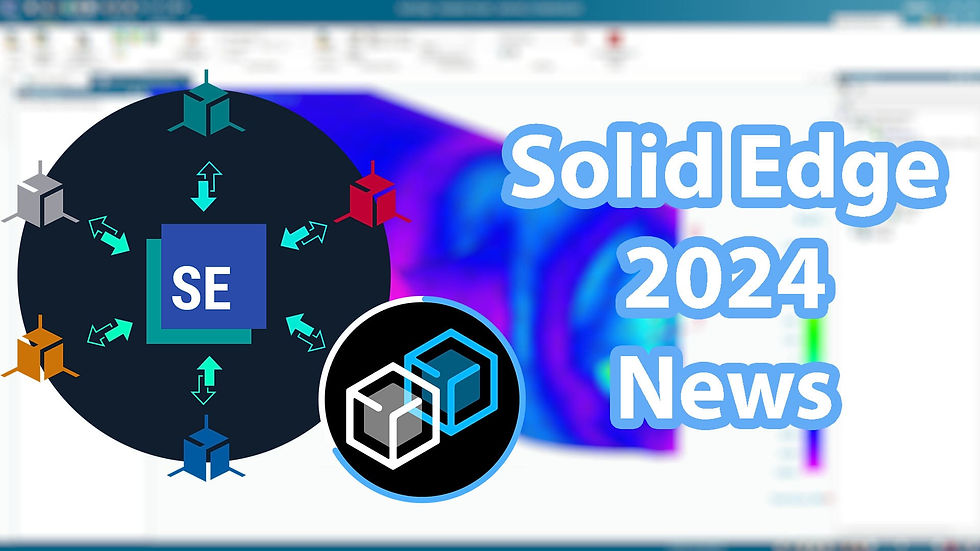What's new in Solid Edge 2024
- Alvaro Filho

- Apr 5, 2024
- 3 min read
Increase simulation speed, performance, and reliability.

Enhancements to Solid Edge Simulation and Simcenter FLOEFD for Solid Edge increase simulation performance and speed with improvements to meshing, structural analysis, and interoperability. The new compact IGBT model makes it easy to incorporate electronics into your simulation studies, while the Cartesian Mesh Generator and improved mesh quality checks enable faster meshing and simulation workflows, resulting in a mesh speed of two to three times faster.
Solid Edge Simulation
Increased interoperability allows Solid Edge Simulation users to import solid temperature results from a Simcenter FLOEFD study into Solid Edge. A new command within Solid Edge Simulation's "External Loads" option, "Import Solid Temperature", is now supported, in addition to the previous commands "Import Fluid Pressure" and "Import Fluid Temperature". This command is only available with linear static studies and is useful for finding thermal stresses and strains in solids.
The new option to apply force at any user-defined point allows greater control of simulation studies. The option has been added to the Force command bar, allowing users to apply forces to any 2D or 3D point in geometry, increasing capabilities alongside the traditional "Point" option that supported vertex selection.
The visualization of mesh quality controls has been improved to facilitate the identification of areas of poor quality. Colors are now clearer and easier to decipher, and users can increase efficiency by being able to detect errors instantly. Users can also change the filled color of failed elements in the "Check Element Quality" dialog box for better visibility.
Simcenter FLOEFD para Solid Edge
Compact IGBT model and Cartesian mesh generator
The Insulated Gate Bipolar Transistor (IGBT) compact model is now comprised of compact electrical element and two-resistor (2R) component models, providing an efficient representation of the IGBT element.
The IGBT element can be described by specifying junction thermal resistances up or down. A set of IC plots for different temperature values can also be defined for detailed analysis and characterization by users.
The IGBT edit definition dialog box allows users to easily add the model to a specific analysis. The junction temperature is used to determine the Electrical Power from the IV graph, which is then applied to the model through the 2R component.
The Cartesian mesh generator in Simcenter FLOEFD for Solid Edge ensures optimized performance, providing faster meshing while using fewer resources. With accelerated operations, including smart printed circuit board (PCB) importing and meshing, overall efficiency is improved with faster simulation and meshing workflows. Enhanced visualization capabilities and continuous updates after parameters are changed further enhance the overall workflow.

Enhanced structural analysis
Simcenter FLOEFD for Solid Edge can be connected to the Nastran Simcenter 3D (SC3D) Solver, unlocking the power of nonlinear analysis. The SC3D Nastran solver 401 introduces additional settings in the Calculation Control Options, allowing you to fine-tune simulations. Settings include adjusting scratch memory, refining contact mode, controlling solver steps, setting end time, and exploring large displacement scenarios. The enhancements also provide greater flexibility and control in nonlinear analysis and greater accuracy when working with large displacements.
Tolerance-based contacts enable accurate simulations with enhanced contact options. Tolerances can be specified to create gapped body contacts, linear and angular tolerances can be defined, and glue contacts can be created seamlessly to ensure accurate and reliable simulation results.
The User Defined Maximum Aspect Ratio in Local Mesh feature enhances the structural mesh with greater accuracy. By specifying maximum proportions for specific components, efficiency can be improved with greater control over the meshing process, especially for thin structures.
Additional Enhancements
With the powerful Component Explorer, users can manage component attributes, experience simplified organization, and employ efficient component management. Thermal component lists can be exported and imported, allowing easy editing of properties such as material, volume source value, two resistor power (2R), and light-emitting diode (LED) current. Users can simply export the list of components to Microsoft Excel, make the necessary changes, and then seamlessly import the list, simplifying their workflow.
Teamcenter FLOEFD item customization offers greater flexibility and adaptability. Users can customize the Simcenter FLOEFD data model for Solid Edge to align with specific requirements and conveniently store FLOEFD data model files using local storage or Teamcenter storage. This customization can also seamlessly integrate FLOEFD into an existing data management system.
Simcenter FLOEFD 's enhanced Linux solver for Solid Edge now supports co-simulation with Functional Mock-ups (FMUs) exported from other software, enabling integrated and comprehensive analysis. This solution ensures smooth compatibility and allows users to leverage all essential information stored within the FMU exported from FLOEFD, including model geometry.
Increase the efficiency of your simulations right now! With enhancements to Solid Edge Simulation and Simcenter FLOEFD for Solid Edge, you can experience a significant increase in the speed, performance, and reliability of your analyses. Schedule a meeting with CAEXPERTS today and discover how we can optimize your simulations for guaranteed success.


